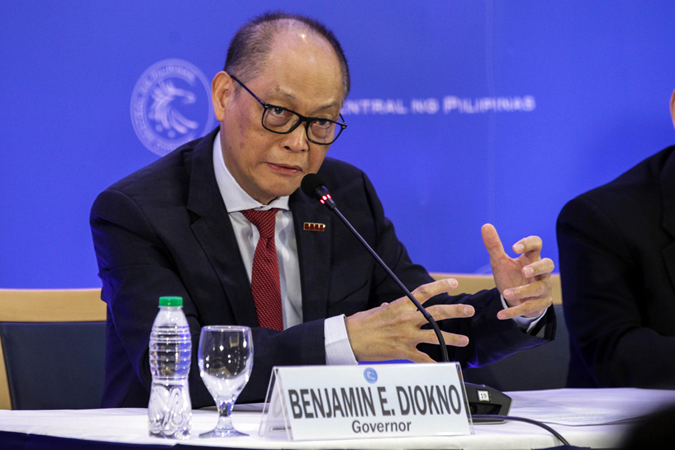Poll: BSP to keep rates untouched for now

Luz Wendy T. Noble, Reporter
THE Bangko Sentral ng Pilipinas (BSP) is widely expected to retain its prudent pause, amid a continued supply-side-induced spike in inflation and the decline in lending activity.
Some analysts believe the central bank will remain accommodative and refrain from policy adjustments for the rest of the year, as the outlook for recovery darkens.
All 19 analysts polled by BusinessWorld were unanimous in predicting there will be no change in the record-low policy rate when the Monetary Board meets on March 25.
A decision to pause will afford the economy “more breathing room” in the meantime as the central bank sees “little evidence of second-round effects” for now, said ING Bank N.V. Manila Senior Economist Nicholas Antonio T. Mapa.
“However, should second-round effects emerge or inflation expectations accelerate further, we will not put it past BSP to hike policy rates to defend its price stability objective,” Mr. Mapa said.
Headline inflation reached a 26-month high of 4.7% in February on the surge in food prices.
Officials attributed the uptrend in inflation to supply-side factors such as weather disruptions last year, the African Swine Fever outbreak, and the rising global oil prices. Such things would still have happened whether or not the central bank went for its aggressive 200-basis-point easing last year, BSP officials said.
In February, the central bank maintained the overnight reverse repurchase, lending, and deposit rates at record lows of 2%, 2.5%, and 1.5%, respectively. However, it raised inflation forecast for 2021 to 4% (from 3.2%) and lowered 2022’s projection to 2.7% from (2.9%).
So far, BSP Governor Benjamin E. Diokno has said there is limited evidence of second-round effects such as wage hikes, higher transport fares and rising utility charges.
However, he stressed the BSP is keeping a close eye on inflation developments to determine the appropriate policy course.
Meanwhile, Philippine National Bank Vice-President and Head of Equity Research Division Alvin Joseph A. Arogo said the credit slump will be a major factor that could prevent the BSP from any rate adjustment.
“We believe that raising interest rates amid a fragile economy and low credit expansion environment is counterproductive…the BSP should keep an accommodative monetary environment because higher cost of money will reduce the demand for new private sector loans,” said Mr. Arogo, who expects policy rates to be maintained for the rest of the year.
Outstanding loans disbursed by big banks dropped for the second straight month in January, as lenders remain risk averse amid the crisis. Bank lending has been tepid in the previous months despite the liquidity infusing measures from the central bank.
At this juncture, the central bank is more likely to retain policy settings to allow its November rate cut to be fully felt given monetary policy works with a lag, said Security Bank Corp. Chief Economist Robert Dan J. Roces.
For Maybank Investment Bank Chief Economist Suhaimi Bin Ilias, monetary policy may have to take a backseat as more crucial measures for economic recovery are in the hands of the National Government.
“Policy for recovery should now be focused on — and complemented by — implementing and accelerating COVID 19 vaccinations to achieve herd immunity that will allow for safe reopening of the economy,” he said.
Government officials expect the economy to grow by 6.5% to 7.5% following the record 9.5% contraction in 2020.
However, analysts noted that the Philippines’ recovery prospects are now being clouded by the recent surge in infections and renewed restriction measures.
Meanwhile, a pause from the BSP is likely possible following the US Federal Reserve’s decision to keep policy rates, according to UnionBank of the Philippines, Inc. Chief Economist Ruben Carlo O. Asuncion. He noted that signals from the Fed and the BSP are alike in a way that both acknowledge inflationary threats but have vowed to remain accommodative to support recovery.
“I know that central banks are independent, but we are in a pandemic and there is no playbook for central banks in a pandemic that we know and that works. Recall that the US Fed has been very dovish and has maintained that even if inflation does rise, it will continue to be accommodative in its monetary policy stance,” Mr. Asuncion said.
The Federal Open Market Committee last week kept policy rates near zero to maintain support to the virus-stricken US economy, Neighboring central banks including the Bank of Indonesia and Bank Negara Malaysia have also kept policy rates untouched this month.
Unlike most analysts who either expect the central bank to refrain from cutting rates for the rest of 2021 or to go for a calibrated response once second-round effects become more apparent, analyst Alex Holmes of Capital Economics still believes a rate cut is still on the table to support the crisis-battered economy.
“Provided the recent rise in inflation proves temporary, as we and the central bank expect, then the door could be open for further easing later in the year,” Mr. Holmes said, adding they continue to price in a 50-bp cut within the second half of the year once inflation tapers off.
After Thursday’s meeting, the Monetary Board will have six more policy-setting meetings for the rest of the year. The next one is scheduled on May 13.
